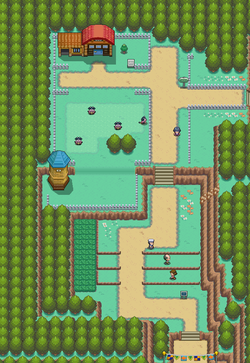

On the 1.0 release of the Japanese versions of Diamond and Pearl, both the menu and the Explorer Kit are usable in a Mystery Zone. It also remains within the internal data of Pokémon HeartGold and SoulSilver. This tileset is actually a slightly distorted depiction of the tileset shown in a pre-release screenshot of Pokémon Diamond and Pearl, indicating that it is a leftover from the development period. Sinnoh's Mystery Zone has its own tileset which can be seen by entering it from the overworld, refreshing the graphics there, and then returning to the overworld. Simply refreshing the graphics will solve this. Upon entering a map ID 0 "Mystery Zone" and accessing a location with a different map ID, the tilesets will not be updated even if the new area is programmed to use a different tileset. In Pokémon HeartGold and SoulSilver, the background music theme is also SEQ_DUMMY but it is a copy of Route 29 instead. In Pokémon Diamond, Pearl, and Platinum, the background music theme is usually the unused copy of Route 206 (Day), which is identified internally as SEQ_DUMMY. It can also be accessed with the use of cheating devices. In earlier copies of the Japanese versions of Pokémon Diamond and Pearl, the Surf glitch is an alternative method. The Mystery Zone is normally inaccessible, but can be entered by means of tweaking. This is because the two are different location IDs that share the name "Mystery Zone" in English games whereas 0x0000 ---- is used for map IDs, 0x07DC なぞのばしょ is used for caught Pokémon. The Japanese versions of Pokémon Platinum, HeartGold and SoulSilver identify the undefined areas as ---- however, they still identify a Pokémon's caught location set to the Mystery Zone as なぞのばしょ. In the Generation IV games, location ID 0x0000 "Mystery Zone" is usually seen in some of the areas found in the void but it is also used for certain unused locations as well as the Underground. Pokémon Brilliant Diamond and Shining Pearl.


 0 kommentar(er)
0 kommentar(er)
